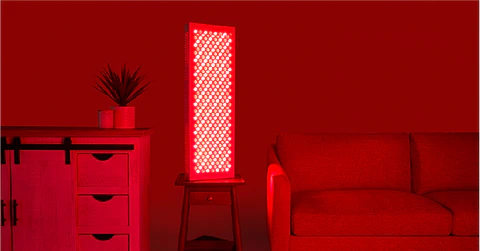Red Light Therapy To Improve Sleep Outcomes
by Rakhi Khurana
Many individuals experience sleep disruptions that contribute to daytime apprehension, disorientation and distress. Studies report that reduced outdoor exposure to natural light amongst older adults may disrupt sleep cycles. Red light therapy has been proposed as a potential prescription intervention to improve sleep quality and activities of daily living.
What is Red Light Therapy?
Red Light Therapy is a non-invasive laser therapy that exposes the body to waves of red and near-infrared light ranging from 600 nanometers (nm) to 900 nm. When red light penetrates the skin barrier, it stimulates mitochondrial production (cellular energy producers) which increases blood circulation and adenosine triphosphate (ATP) levels.
Primary care physicians typically do not recommend full body or partial application of red light therapy as it is not within their scope of education. However, board-certified dermatologists and naturopathic physicians commonly recommend RLT. The endorsement of RLT marks a recent revelation, and with ongoing clinical studies verifying consistently positive outcomes, we may expect primary care physicians to begin advocating for its use.
Alternative names for Red Light Therapy include:
Photobiomodulation phototherapy (PBM)
Low level laser therapy (LLLT)
Light therapy (LT)
What is the difference between Red light Therapy and Sunlight?
Red light therapy utilizes specific wavelengths, while sunlight encompasses a wide spectrum of visible light (400-700 nm), ultraviolet (UV) rays (100-400 nm), and infrared light (700+ nm). Approximately 40% of sunlight comprises red light, with its intensity and dosage varying throughout the day. Sunlight exposure triggers the production of vitamin D, a hormone often misconceived as a vitamin. It's important to note that RLT does not stimulate the production of vitamin D and cannot serve as a substitute for sunlight exposure. Instead, it should complement sun exposure adjacently.
The Biological Mechanism of Red Light Therapy:
RLT is reported to reduce inflammation, promote relaxation, enhance mitochondrial function and improve circadian rhythm optimization.
RLT is reported to increase adenosine triphosphate (ATP), which serves as the cell's energy currency generated by the mitochondria. Given the high density of mitochondria in the brain, a large amount of energy is required for optimal brain function. Increased ATP production leads to various benefits, including accelerated DNA repair, reduced inflammation, decreased fatigue, and enhanced respiratory function.
RLT has been noted to naturally enhance melatonin production, thereby enhancing sleep quality. Melatonin, a hormone primarily produced at night, helps regulate the body's internal clock. Elevated melatonin levels throughout the night support optimal sleep quality and serve as a crucial antioxidant, safeguarding the brain. However, excessive exposure to blue light disrupts the circadian rhythm and suppresses melatonin levels. Blue light plays a role in producing cortisol and serotonin, so it is not inherently harmful during the daytime. The wavelengths of red light (600-750 nm) and blue light (400-490 nm) differ respectively.
What is the Optimal Dosage for Red Light Therapy?
The dosage of RLT is determined by both irradiance and duration. Irradiance indicates the intensity of the light emitted onto a specific area of the body. The recommended duration is 5- 20 minutes, with sessions spaced at least 6 hours apart. It's advisable to start with shorter sessions and gradually increase both the frequency and duration. If not used daily, RLT can be administered 2-4 times a week. Inadequate dosage and low-quality products may lead to ineffectiveness. Adjusting the distance from the device can increase intensity.
Please note that different literary sources may provide diverse dosage suggestions. There isn't one universally applicable prescription. Ultimately, more rigorous clinical studies are necessary to investigate long-term patterns and to draw conclusions regarding the use of red light therapy.
References
Bi, R., Zhang, W., Zhang, D. F., Xu, M., Fan, Y., Hu, Q. X., Jiang, H. Y., Tan, L., Li, T., Fang, Y., Zhang, C., & Yao, Y. G. (2018). Genetic association of the cytochrome c oxidase-related genes with Alzheimer's disease in Han Chinese.
Blue Light vs. Red Light Therapy [2022]. Avanti Body | Weight Loss, Body Sculpting & Rejuvenation. (2024, February 19). https://avantibody.com/blog/blue-light-vs-red-light-therapy
Education, U. C. for S. (n.d.). Center for Science Education. Wavelength of Blue and Red Light | Center for Science Education. https://scied.ucar.edu/image/wavelength-blue-and-red-light-image
Figueiro, M. G., & Rea, M. S. (2010). The effects of red and blue lights on circadian variations in cortisol, alpha amylase, and Melatonin. International journal of endocrinology. https://www.ncbi.nlm.nih.gov/pmc/articles/PMC2905913/
Nizamutdinov, D., Qi, X., Berman, M. H., Dougal, G., Dayawansa, S., Wu, E., Yi, S. S., Stevens, A. B., & Huang, J. H. (2021a, July 1). Transcranial near infrared light stimulations improve cognition in patients with dementia. Aging and disease. https://www.ncbi.nlm.nih.gov/pmc/articles/PMC8219492/
Stepanov, Y. V., Golovynska, I., Zhang, R., Golovynskyi, S., Stepanova, L. I., Gorbach, O., Dovbynchuk, T., Garmanchuk, L. V., Ohulchanskyy, T. Y., & Qu, J. (2022a, June 18). Near-infrared light reduces β-amyloid-stimulated microglial toxicity and enhances survival of neurons: Mechanisms of light therapy for alzheimer’s disease - alzheimer’s research & therapy. BioMed Central. https://alzres.biomedcentral.com/articles/10.1186/s13195-022-01022-7

